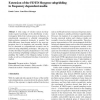Free Online Productivity Tools
i2Speak
i2Symbol
i2OCR
iTex2Img
iWeb2Print
iWeb2Shot
i2Type
iPdf2Split
iPdf2Merge
i2Bopomofo
i2Arabic
i2Style
i2Image
i2PDF
iLatex2Rtf
Sci2ools
59
Voted
ADT
2010
2010
Extension of the FDTD Huygens subgridding to frequency dependent media
Abstract A wide range of wireless system developments require knowledge of the distribution of electromagnetic fields from various sources in humans. As experimental assessment is ethically unacceptable, high-resolution numerical dosimetry is needed. The finite-difference time-domain method is the most appropriate due to its simplicity and versatility. Reduction in demands on computational resources can be achieved using subgridding techniques. This paper rigorously introduces frequency dependency to one of the most promising subgridding techniques, Huygens subgridding. The validity of the Huygens surface in lossy media, as well as on the physical interface, is intensively studied. Keywords Huygens surface
ADT 2010 | Finite-Difference Time-Domain | Finite-difference Time-domain Method | Numerical Dosimetry | Programming Languages |
| Added | 08 Dec 2010 |
| Updated | 08 Dec 2010 |
| Type | Journal |
| Year | 2010 |
| Where | ADT |
| Authors | Fumie Costen, Jean-Pierre Bérenger |
Comments (0)

